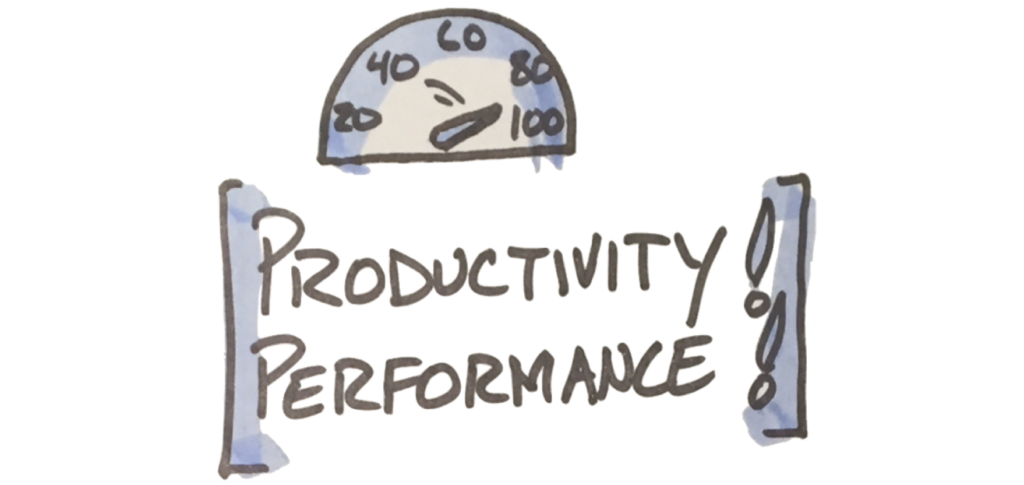
I bet you have been asked to either improve the productivity of your teams or justify your teams performance. How did you respond to that request? Did you hem and haw and talk about how hard they are working? Did you point to their velocity and show how much output they were producing? I wrote up a conversation you may want to have with your boss next time he or she brings this up…
The Conversation
BOSS: “Hey we are spending too much, I need your teams to be more productive!”
YOU: “Great. I’m glad your interested in the performance of our teams. What do you mean by ‘productive’?”
BOSS: “We need to get more features out the door, the competition has features compelling the customers.”
YOU: “OK, thanks. Delivering more features each release would make them more productive.”
BOSS: “Yes. You just repeated what I said.”
YOU: “Sure. A question though. If they deliver more features in the release, but it takes them longer to release it, is that OK?”
BOSS: “No, of course not. We have to deliver more features in the same time, or maybe even less time. The competition is beating us.”
YOU: “Oh, I see. So we need to deliver more features in the same, or less, time.”
BOSS: “There you go again repeating me.”
YOU: “Yes, sorry. Can I ask you another question?”
BOSS: “Sure, but make it quick because I have a lot to do.”
YOU: “Sure. If we deliver more features in less time, but it costs more, is that OK?”
BOSS: “No, if it costs more, that’s the same as extending time. The whole point of being more productive is to get more with less – less time and less money.”
YOU: “OK. Do more with less time and less m – oh, I am repeating you again. Is it OK to lower quality to achieve this goal?”
BOSS: “Now you are just toying with me. Of course our quality must be maintained, and probably should be improved as well. We hear complaints about that as well sometimes.”
YOU: “I just want to confirm we are on same page. We need to deliver more in less time and money with equal or greater quality.”
BOSS: “Yes, that I what I am asking for.”
YOU: “Sounds reasonable. What if we do all that, but deliver features our customers don’t want or don’t like?”
BOSS: “How many variables are you going to keep bringing up? We must maintain our usability, scalability, reliability, and all of the other ‘ilities’ that make sure our features are done right. That’s why I hired you.”
YOU: “Sure, that makes sense and why I am asking you these questions. I just have one more question though. Is it OK if we produce more features with less time and money, increase quality and customer satisfaction (and all other ‘ilities’), if we end up burning out our employees to accomplish all this?”
BOSS: “Hmm. Is that important?”
YOU: “Well, that depends on whether you would intend to repeat this objective next quarter, and the next, and the next, etc.”
Outputs and Outcomes
Whenever bosses ask for improved productivity or increased performance – it is a request for more output. Maybe more features, maybe more widgets manufactured, maybe more services delivered. Productivity is measured as the rate of output per unit of input. Inputs in this case are people, time, resources, etc. which cost the company money. Outputs are typically products or services to be sold.
This conversation should help lead the boss to more fully understand that the outcome he or she hopes to achieve is complex. There are many variables involved in creating a complex outcome and it cannot be engineered – it must emerge from the system. We can engineer a feature delivery, but we cannot engineer a customer to like our product. Outputs lead to outcomes, but not directly or linearly.
Performance + Health
More, faster, cheaper are performance measures.
Better quality, customer satisfaction and employee engagement are health measures.
In the research by McKinsey consultants, and illustrated in their book Beyond Performance, Scott Keller and Colin Price share that organizations that focus on performance actually underperform organizations that focus on a balance of performance and health.
This is true over the long-term view, as performance is typically focused on a short-term result while health is focused on long-term value. So while a company may be able to outperform another by limiting their focus on the health issues, it will unlikely sustain that advantage and the long-term value will overtake it in time.
Agile Leaders recognize that balance is required in developing and sustaining value. Shortcuts will likely provide short-term success followed by long term debt. Don’t be a BOSS. Be an Agile Leader.
